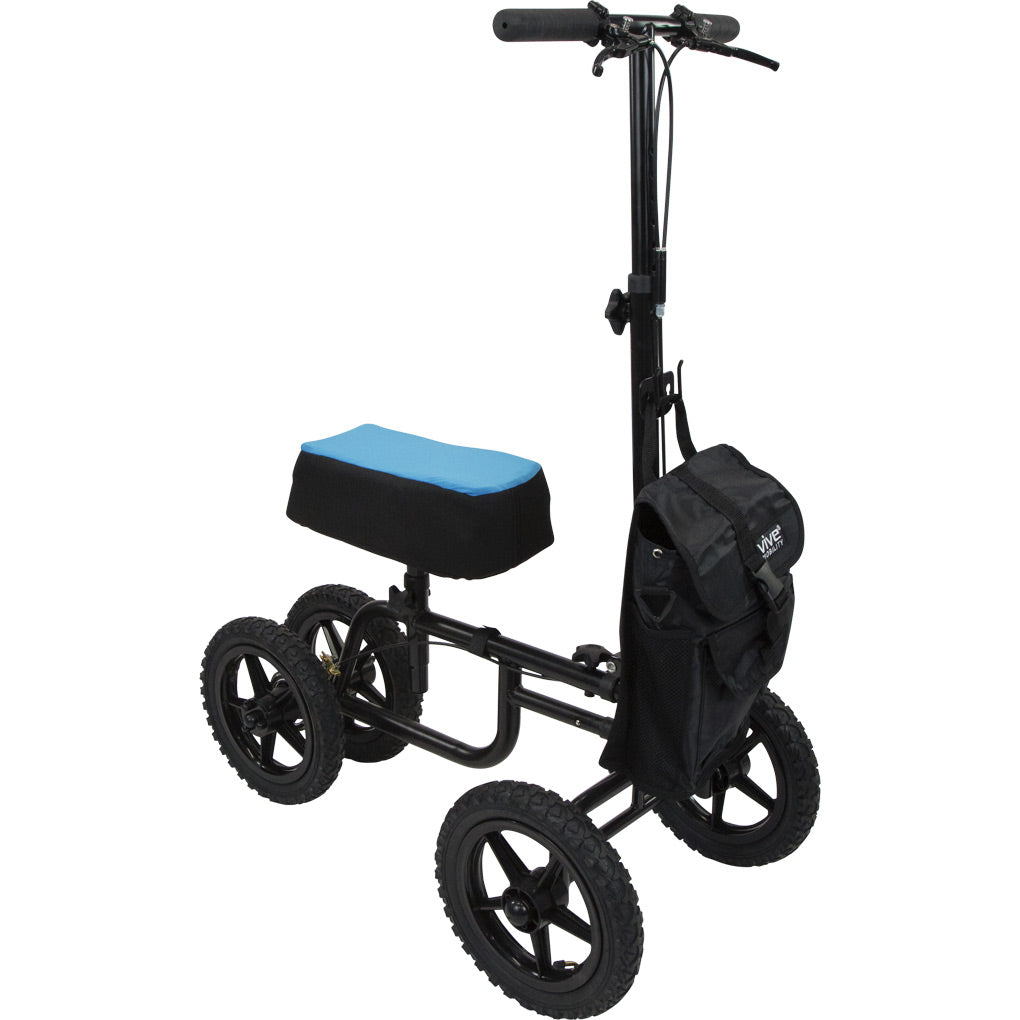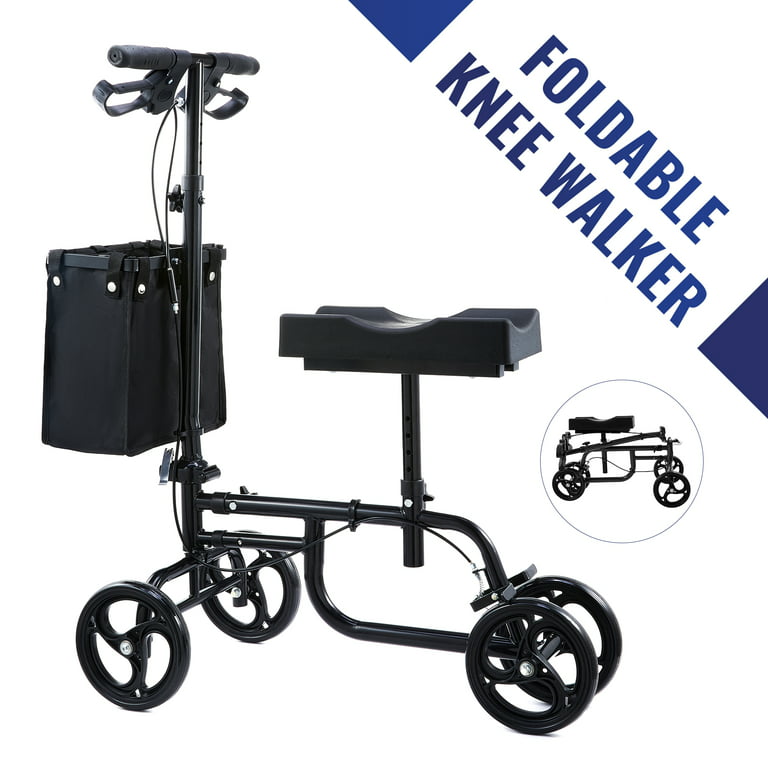Knee scooters and wheelchairs are both mobility aids, but each has its advantages and disadvantages. While knee scooters allow for greater mobility and can be a good alternative to crutches, they are not suitable for navigating stairs and can be challenging to transport.
Wheelchairs, on the other hand, are better for individuals with balancing issues or poor upper body strength who cannot put weight on their injured leg. Ultimately, the choice between a knee scooter and a wheelchair depends on the specific needs and circumstances of the individual.

Credit: www.tyconmedical.com
Advantages Of A Knee Scooter
A knee scooter offers several advantages over a traditional wheelchair, making it a popular choice for individuals with injuries or mobility issues. From improved mobility to easier navigation on uneven surfaces, a knee scooter provides numerous benefits for users.
Improved Mobility
A knee scooter allows individuals to maintain their independence and mobility, even with an injured leg or foot. Unlike a wheelchair that requires sitting all the time, a knee scooter enables users to keep the affected leg elevated while moving around effortlessly. This freedom of movement prevents muscle atrophy and allows users to regain their mobility faster.
Easier Navigation On Uneven Surfaces
One of the significant advantages of a knee scooter is its ability to navigate uneven surfaces with ease. Thanks to their sturdy and stable design, knee scooters offer improved balance and control on various terrains, including gravel, grass, and uneven sidewalks. Unlike wheelchairs, which may get stuck or tip over on uneven surfaces, knee scooters provide a smoother and more comfortable ride.
In conclusion, a knee scooter is a superior mobility aid due to its advantages of improved mobility and easier navigation on uneven surfaces. If you’re looking for a convenient and efficient alternative to a wheelchair, consider opting for a knee scooter.

Credit: www.amazon.com
Advantages Of A Wheelchair
When it comes to choosing between a knee scooter and a wheelchair, there are several advantages to consider. A wheelchair is a mobility aid that offers unique benefits for individuals with specific needs. Let’s explore two key advantages of using a wheelchair:
Suitable For Individuals With Poor Upper Body Strength
For individuals who have limited upper body strength, a wheelchair can be a game-changer. Unlike a knee scooter, which requires the use of your arms and hands to maneuver, a wheelchair provides a seated position with easy-to-use handrails for propulsion. This makes it an ideal option for those who may struggle to bear weight on their injured leg or who have poor upper body strength.
Ideal For Those Who Cannot Bear Weight On Their Injured Leg
If you cannot put any weight on your injured leg, a wheelchair is the best choice for ensuring mobility and independence. With a wheelchair, you can move around freely and comfortably without worrying about putting any pressure on your injured leg. It provides a stable and supportive platform for individuals with leg injuries, allowing them to navigate their surroundings with ease.
Disadvantages Of A Knee Scooter
One disadvantage of a knee scooter is that it cannot be used on stairs, similar to a wheelchair. Additionally, although lighter than a wheelchair, a knee scooter can still be challenging to transport. Another drawback is that knee scooters tend to be more expensive than other mobility aids.
While a knee scooter can be a helpful mobility aid for individuals with lower leg injuries, it also comes with its own set of disadvantages that need to be considered. Two common disadvantages that knee scooters share with wheelchairs are the difficulty of using them on stairs and transportation challenges. Additionally, knee scooters tend to be higher in cost compared to other mobility aids.
Difficulty Using On Stairs
One major disadvantage of a knee scooter is that it cannot be used on stairs. Due to its design, which relies heavily on one’s ability to balance and maneuver on a flat surface, navigating stairs becomes virtually impossible. This limitation can make it challenging for individuals who have to regularly navigate staircases in their daily routine, such as in their homes or public places.
Transportation Challenges
Transporting a knee scooter can also pose challenges. Although they are lighter in weight compared to wheelchairs, knee walkers can still be bulky and require storage space when not in use. Additionally, their size and shape may not be easily accommodated in certain modes of transportation such as compact cars or public transportation. This can limit the flexibility and ease of transportation for individuals who rely on knee scooters as their primary mobility aid.
Higher Cost
Last but not least, knee scooters tend to come with a higher price tag compared to other mobility aids. The advanced design, materials, and functions of knee scooters contribute to their higher cost. This can be a significant factor to consider, especially for individuals who have limited financial resources or do not have insurance coverage for mobility aids. The higher cost can limit the affordability and accessibility of knee scooters for some individuals.
Choosing The Best Mobility Aid For A Broken Foot Or Ankle
When deciding between a knee scooter and a wheelchair for a broken foot or ankle, it’s important to weigh the pros and cons. While a knee scooter allows for resting the injured foot and easier mobility on flat surfaces, a wheelchair may be a better choice for those with balancing issues or limited upper body strength.
Consider your specific needs and consult with your healthcare team to choose the best mobility aid.
Factors To Consider
When choosing the best mobility aid for a broken foot or ankle, there are several factors to consider. These factors will help you make an informed decision about whether a knee scooter or a wheelchair is the right choice for you.
1. Level of mobility: Evaluate your level of mobility and the extent to which you can put weight on your injured leg. If you can’t bear any weight at all, a wheelchair may be more suitable. However, if you can partially bear weight, a knee scooter can provide the necessary support while allowing you to move around more freely.
2. Duration of use: Consider the duration for which you will need a mobility aid. If it’s only for a short-term recovery period, a knee scooter could be a cost-effective option. On the other hand, if you anticipate needing assistance for an extended period or have a chronic condition, a wheelchair might offer greater long-term comfort and stability.
3. Physical condition: Assess your physical condition and any other limitations or pre-existing medical conditions. If you have difficulty with balance or stability, a wheelchair with proper support and safety features may be the safer choice. Additionally, check if you have the upper body strength required to operate a knee scooter effectively.
4. Lifestyle and activities: Take into account your lifestyle and the activities you need to perform on a daily basis. If you have an active lifestyle or need to navigate rough terrains, a knee scooter with all-terrain capabilities may be more suitable. However, if you require assistance with tasks such as carrying items or maneuvering through narrow spaces, a wheelchair could provide more convenience.
Recommendations For Different Situations
Based on different situations, here are our recommendations to help you choose the best mobility aid for a broken foot or ankle:
1. Short recovery period: If you have a short recovery period and expect to regain mobility relatively quickly, a knee scooter could be a practical and cost-effective choice. Its maneuverability and compact design make it suitable for indoor use and navigating tight spaces.
2. Long-term or chronic condition: If you have a long-term or chronic condition, or if you anticipate needing mobility assistance for an extended period, a wheelchair provides greater comfort and stability. Consider an electric wheelchair for added convenience and reduced physical exertion.
3. Active lifestyle: If you lead an active lifestyle and want to maintain your mobility while recovering, a knee scooter with all-terrain capabilities is ideal. It will allow you to navigate outdoor environments and uneven surfaces with ease.
4. Post-surgery: Following a surgical procedure, your healthcare provider may recommend a specific mobility aid. It’s crucial to follow their guidance to ensure a successful recovery.
Remember, making the right choice depends on your unique circumstances and personal preferences. Consult with your healthcare provider or physical therapist to determine the best mobility aid for your broken foot or ankle.
Frequently Asked Questions Of Knee Scooter Vs Wheelchair
What Are The Disadvantages Of A Knee Scooter?
The disadvantages of a knee scooter include its inability to be used on stairs and its difficulty in transportation. Additionally, knee scooters can be expensive compared to other mobility aids.
When Should You Use A Knee Scooter?
A knee scooter should be used if you have an injured leg and need assistance with mobility. It helps you avoid putting weight on your injured leg. Your healthcare team will provide specific instructions on how much weight you can put on your leg.
It is a good alternative to crutches or a wheelchair during the recovery process.
What Is Better A Wheelchair Or A Scooter?
A wheelchair is better for those with limited upper body strength or extensive accessibility needs. A scooter is best for those who can get around without help but struggle with long distances.
What Is The Best Mobility Aid For Bad Knees?
The best mobility aid for bad knees includes knee scooters, rollators, wheelchairs, basic mobility scooters, walking sticks, crutches (short-term use), standard walkers, and all-terrain motorized wheelchairs. It depends on the surface and terrain.
Conclusion
Based on the comparison between knee scooters and wheelchairs, it is clear that both options have their advantages and disadvantages. While knee scooters allow for greater mobility and ease of use on flat surfaces, wheelchairs are better suited for individuals with poor upper body strength or balancing issues.
Ultimately, the choice between a knee scooter and a wheelchair depends on individual needs and preferences.

